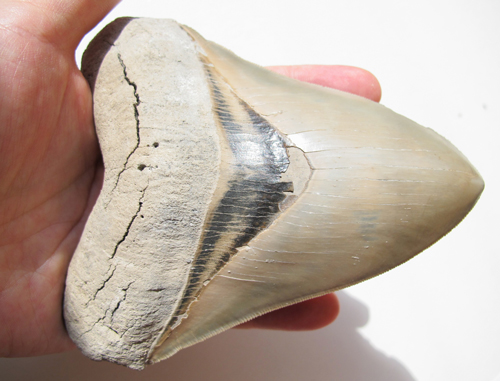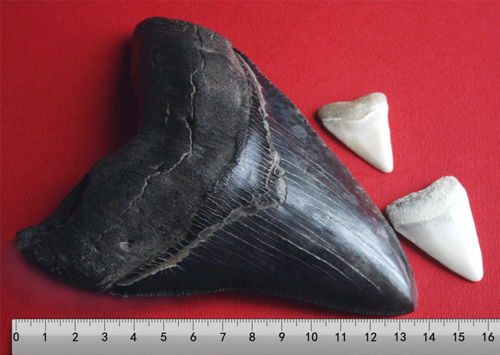The largest sharks that ever lived, Otodus megalodon, maintained warmer body temperatures than their modern analogues, according to a recent geochemical analysis of fossil shark teeth.

“This project uses “isotopic fingerprinting” of teeth of megalodon and other marine vertebrates to determine not only their body temperatures but also their dietary behavior and ambient seawater chemistry during the past 15 million years,” Kenshu Shimada, a paleobiology professor at DePaul University in Chicago, Ill., told Eos. Shimada, a member of the team that analyzed the teeth, is working with his group to understand the ancient sharks’ biology and habitat, searching for clues on what drove the creatures to extinction.
Because they were such dominant apex predators, “the extinction of the presumed gigantic predator, O. megalodon, must have been at least in part responsible in shaping the composition of the present-day marine biodiversity,” he explained.
The team presented preliminary results of this research yesterday at AGU’s Fall Meeting 2018 in Washington, D. C.
Megalodon: Hot or Cold?
O. megalodon thrived during the Miocene and Pliocene epochs 23–2.5 million years ago and likely went extinct as glaciers began to dominate the planet around 2 million years ago. Fossils of O. megalodon have been discovered in tropical and temperate coastline and continental shelf regions on every continent except Antarctica. The ancient sharks likely grew up to 20 meters long and may have weighed more than 20,000 kilograms, making it the largest fish that has ever lived.
The sharks’ body temperature and their ability to regulate it may have played a large role in their extinction.
One of the largest unanswered questions about this ancient apex predator is whether it was warm-blooded (endothermic) or cold-blooded (ectothermic), said co–principal investigator Michael Griffiths, a geochemist and a professor of environmental science at William Paterson University (WPU) in South River, N.J. The sharks’ body temperature and their ability to regulate it may have played a large role in their extinction, he explained.
“Megalodon thrived in a warm Earth,” Griffiths said. It is possible that “when we went into an ice age, they couldn’t adapt, because they were so large and they would have had to eat a lot of food to sustain their body temperature.”
Moreover, “if O. megalodon were ectothermic, maybe it just couldn’t adapt to the higher latitudes where it was cooler, to chase down its primary food sources,” like whales, he said.
Isotope Clumps in Teeth
To learn more, the team is turning to fossil records to determine whether O. megalodon’s body temperature and source of food were different in the Pliocene compared with the earlier Miocene. Almost all O. megalodon fossils are teeth, and tooth enamel is the most well preserved material. What physiological clues, if any, could it hold?

The answer rests on a relatively new biogeochemical technique called clumped isotope thermometry (CIT). With this technique, the researchers are testing whether isotope ratios in shark teeth can be used as proxies for body temperatures.
CIT pinpoints the concentrations of oxygen-18 (18O) and carbon-13 (13C) isotopes within the carbon dioxide (CO2) of tooth enamel. These two isotopes, which are commonly found in fossilized carbonate material, clump together with strong bonds but are weakly attached to other C and O isotopes. It’s not energetically favorable for heavier CO2—e.g., with 18O, 13C, and a light oxygen isotope—to exist at higher temperatures. So a lower concentration of clumped isotopes in enamel CO2 means that the enamel formed at a higher body temperature. This thermometer is independent of the composition of the water that the shark swam in.
“Clumped isotope thermometry tests for the temperature of the animal,” said Allison Neumann, a WPU undergraduate student and one of the lead researchers on the project. “We can use that, along with seawater temperature, to figure out whether [O. megalodon] really was an endotherm or an ectotherm.”
A New Approach to Megalodon Isotopes

To test whether the method works, the researchers first calibrated their CIT analysis using teeth from aquarium sharks and wild specimens from areas with temperature records.
“Our study investigates a variety of sharks, including lineages that have modern representatives such as the great white, mako, and sand tiger sharks, as well as a number of bony fish and marine mammal taxa, including whales,” Shimada said. Using teeth from modern sharks as comparative benchmarks was key to compare O. megalodon measurements with those of known endothermic and ectothermic marine vertebrates, he said.
After confirming that CIT accurately measured the body temperatures of modern sharks, the team moved on to O. megalodon teeth. In this, the extinct shark’s size was a distinct advantage, Griffiths explained. One megalodon tooth provides enough enamel for a full CIT measurement, whereas 15–20 modern shark teeth were needed to provide enough enamel for one measurement, he said.
“Megalodon was quite a bit warmer than its coexisting shark species and other sharks such as great whites.”
The preliminary CIT results were very encouraging, the team reported. “The analyses are telling us that megalodon was quite a bit warmer than its coexisting shark species and other sharks such as great whites,” Griffiths said. He stressed that their results were still preliminary and that they require more CIT measurements to be sure. However, “these are sort of the first clues as to what may have led to the extinction of O. megalodon,” he said.
“The geochemistry techniques used are very promising,” said Catalina Pimiento, a postdoctoral fellow at Swansea University in Swansea, Wales, who is studying the paleobiology and paleoecology of sharks. This technique “may overcome the difficulties of other, more traditional isotopic techniques that have failed to inform us on important life history traits of extinct sharks,” said Pimiento, who was not involved with this research.
Painting a Picture of Extinction
Griffiths and his team have only just begun their CIT analysis of O. megalodon teeth. They plan to conduct more CIT analyses to refine their modern shark benchmarks and analyze more Miocene and Pliocene fossils.
The researchers also plan to analyze the fossil teeth using more traditional isotope analyses. For example, a low calcium-44 to calcium-40 ratio suggests a food source that is high in the food chain and could show whether O. megalodon preyed on different animals during different epochs. The ratio of 16O to 18O in a tooth’s carbonates and phosphates would reveal seawater chemistry and temperature, just as it does in corals, sediments, and other paleoclimate archives.
When combined, these biogeochemical techniques could paint a more complete picture of O. megalodon’s last years.
“So far, we have uncovered the potential role of sea level and consequent area loss in the extinction of O. megalodon,” Pimiento said. “This project may provide additional clues on the role of thermoregulation and sea temperature.”
—Kimberly M. S. Cartier (@AstroKimCartier), Staff Writer
Citation:
Cartier, K. M. S. (2018), Extinct megatoothed shark may have been warm-blooded, Eos, 99, https://doi.org/10.1029/2018EO111687. Published on 11 December 2018.
Text © 2018. The authors. CC BY-NC-ND 3.0
Except where otherwise noted, images are subject to copyright. Any reuse without express permission from the copyright owner is prohibited.

